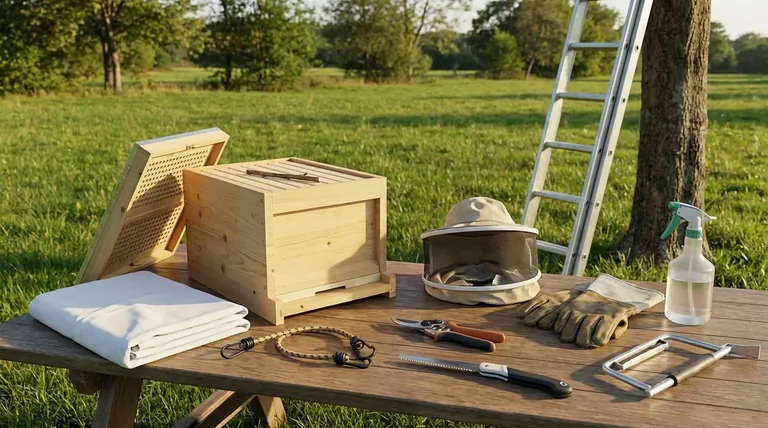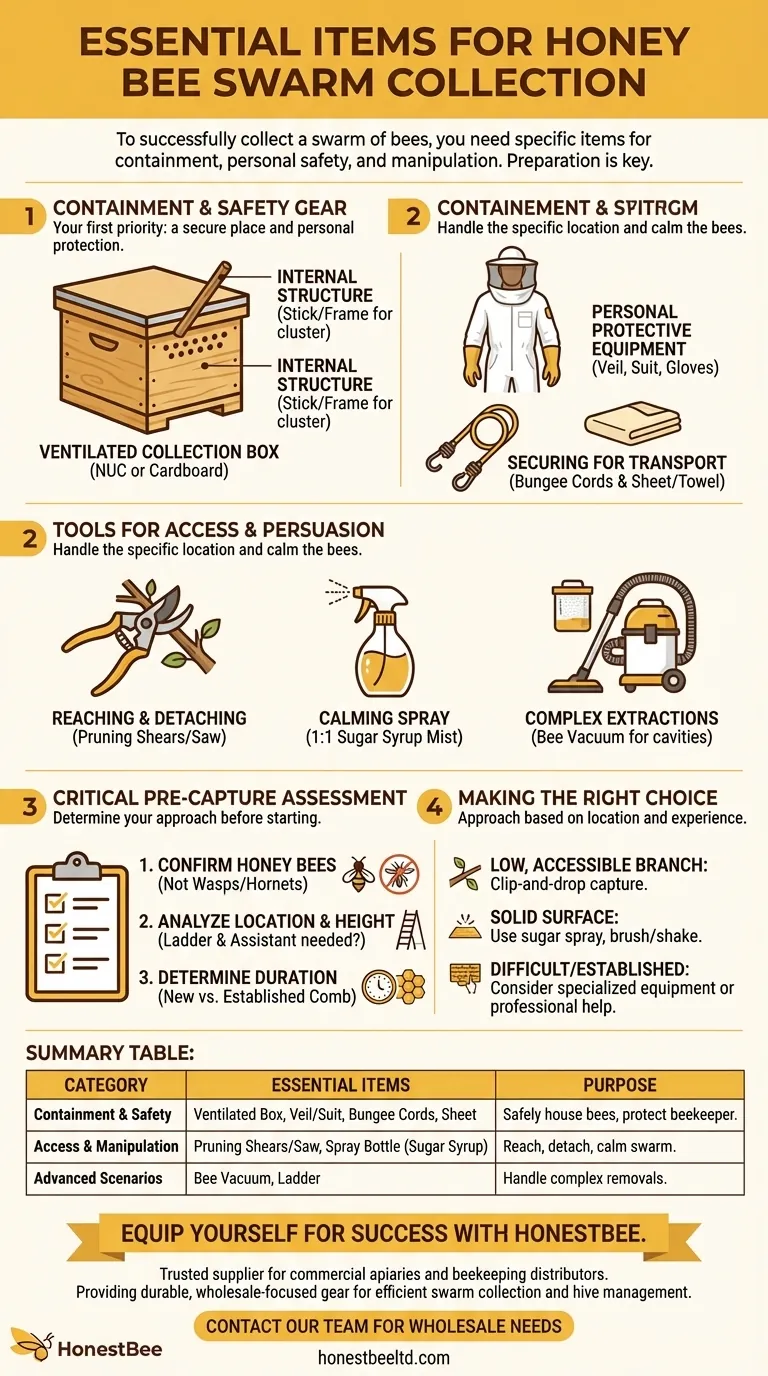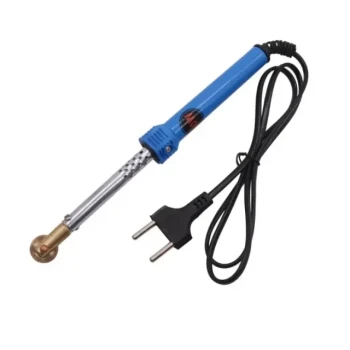To successfully collect a swarm of bees, you need a specific set of items for containment, personal safety, and physically manipulating the swarm. The essential toolkit includes a ventilated box to house the bees, protective clothing like a beekeeper's veil, and tools like pruning shears for detaching branches. You will also need items to calm the bees and secure the box for transport.
The key to a safe and successful swarm capture is not just having the right equipment, but first conducting a critical assessment of the situation. Your preparation is as important as your tools.

Essential Gear for Containment and Safety
Your first priority is to have a secure place to put the bees and to ensure you are protected during the process.
The Collection Box
The swarm needs to be placed into a temporary home. A simple, sturdy cardboard box can work, but a dedicated nucleus box (nuc) from a beekeeping supplier is ideal.
If using cardboard, ensure the bottom is thoroughly taped to prevent collapse. The box must have openings for ventilation so the bees do not overheat.
Internal Structure
Place a stick or a small frame diagonally inside the box. This simple addition gives the bees a surface to hang onto and begin clustering, which helps keep them calm and organized after being captured.
Personal Protective Equipment
At an absolute minimum, you must wear a beekeeper's veil. Stings to the face are particularly dangerous.
For greater safety, a full bee suit or at least a jacket, along with gloves, is highly recommended to protect you from stings on the rest of your body.
Securing the Swarm for Transport
Once the bees are inside, you need to seal the box securely. Use an old bed sheet or a large towel to cover the entrance and any ventilation holes.
Use two or more bungee cords to wrap around the entire box, ensuring the lid and the sheet stay firmly in place during movement.
Tools for Access and Persuasion
With your safety and containment prepared, you need tools to handle the specific location of the swarm.
Reaching and Detaching the Swarm
Many swarms conveniently land on tree branches. Pruning shears for small limbs or a pruning saw for larger ones allow you to snip the branch and gently lower the entire cluster into your box.
Calming and Guiding the Bees
A spray bottle filled with a 1:1 sugar syrup (one part sugar, one part water) is invaluable. A light mist calms the bees, makes them less inclined to fly, and encourages them to focus on cleaning themselves.
Handling Complex Extractions
For swarms located inside walls or other inaccessible cavities, a specialized bee vacuum may be required. This is an advanced tool that gently sucks the bees into a ventilated chamber without harming them.
Critical Pre-Capture Assessment
Before you gather your tools, you must assess the situation. Answering these questions will determine your approach and the specific equipment you need.
Confirm They Are Honey Bees
First, be absolutely certain you are dealing with a honey bee swarm. Wasps, hornets, and yellow jackets are far more aggressive, do not swarm in the same way, and require professional pest control, not a beekeeper.
Analyze the Location and Height
Note the swarm's height. If it is high off the ground, you will need a sturdy ladder and possibly an assistant.
Also, determine what the bees are clustered on. A branch that can be cut requires a different approach than a swarm on a fence post, a wall, or the side of a car, which may require you to gently brush or shake the bees into the box.
Determine How Long They Have Been There
A swarm that just arrived is typically docile and easy to collect. If it has been in place for several days, the bees may have started building comb. This makes the removal more complex and increases the importance of ensuring the queen is collected with the cluster.
Making the Right Choice for Your Goal
Your approach will change based on the swarm's location and your level of experience.
- If the swarm is on a low, accessible branch: Your primary tools will be the box, pruners, and protective gear for a straightforward clip-and-drop capture.
- If the swarm is on a solid surface: The sugar spray becomes essential to manage the bees as you gently encourage them into the box with a firm shake or by brushing them.
- If the swarm is in a difficult or established location: This may require specialized equipment like a bee vacuum, and you should strongly consider contacting an experienced local beekeeper for assistance.
Proper preparation and the right equipment transform a potentially daunting task into a manageable and rewarding one.
Summary Table:
| Category | Essential Items | Purpose |
|---|---|---|
| Containment & Safety | Ventilated Box (Nuc/Cardboard), Beekeeper's Veil/Suit, Bungee Cords, Bed Sheet | Safely house the bees and protect the beekeeper. |
| Access & Manipulation | Pruning Shears/Saw, Spray Bottle (Sugar Syrup) | Reach, detach, and calm the swarm. |
| Advanced Scenarios | Bee Vacuum, Ladder | Handle complex removals from cavities or high locations. |
Equip yourself for success with HONESTBEE.
As a trusted supplier for commercial apiaries and beekeeping equipment distributors, we provide the durable, wholesale-focused gear you need for efficient swarm collection and hive management. From professional-grade nucleus boxes to protective suits, our products are built to support your operations.
Contact our team today to discuss your wholesale needs and ensure you're prepared for your next swarm capture.
Visual Guide

Related Products
- Multi-Function Plier-Style Frame Grip Hive Tool
- HONESTBEE Professional Long Handled Hive Tool with Precision Cutting Blade
- Professional Stainless Steel Pry-Bar Hive Tool
- Professional Multi-Function Stainless Steel Hive Tool
- Plastic Queen Bee Catcher Marker Tube Holder for Queen Marking Bottle
People Also Ask
- What types of hive tools are available for beekeepers? Choose the Right Lever for Your Apiary
- What is the correct method for lifting frames with a hive tool? Master the Technique for a Calm Hive
- How do you tell if a hive has a queen? Look for These 3 Key Signs in Your Brood Frames
- How are eyelets installed in the frame? Protect Your Beehive Frames from Wire Damage
- What are the normal functions of a hive tool? The Essential Multi-Tool for Every Beekeeper



















